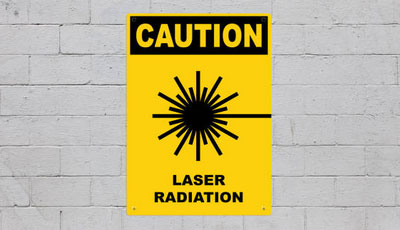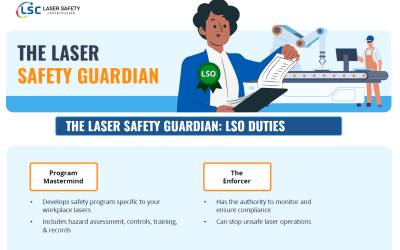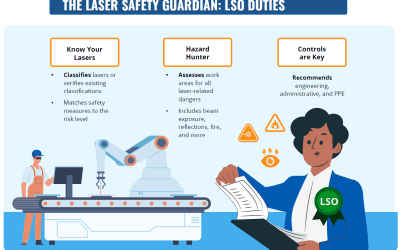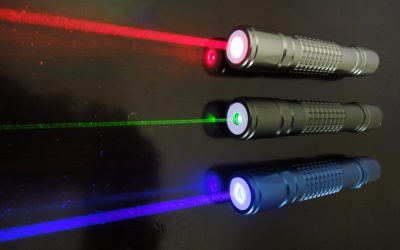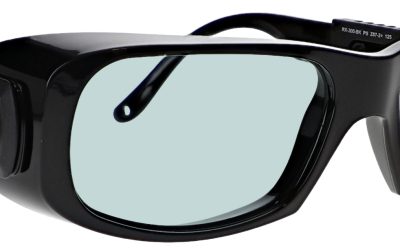7 Keys to a Successful Laser Safety Training Program
Lasers make many hard jobs easier and cheaper. They have industrial applications and cut down on the wear and tear of machinery. This is because lasers focus high energy on a small area. Lasers are widely used in research labs, medicine, and even hair and tattoo removal. They can cut and weld hard metals and treat delicate human tissue.
Along with their advantages are the special dangers they can pose to their users and others around them. Exposure to laser beams in a medical or industrial environment can cause serious and sometimes fatal injuries. Proper Personal Protective Equipment (PPE) is always required when using higher powered Class 3 and Class 4 lasers.
Laser Safety
Laser safety starts with training. But a highly educated workforce is no guarantee that accidents won’t happen.
Some companies don’t provide formal laser safety training, only a brief overview upon employment. As workers become more experienced and complacent, they can lose focus on safety.
OSHA keeps statistics for on-the-job injuries and reports 9 catastrophic or fatal laser related injuries since 1988. Additionally, according to Liberty Mutual, about $1 billion is spent each week on serious but nonfatal work injuries. Many workplace injuries are preventable and are due to a lack of proper training.
A good safety track record is key to a company’s long-term success. It’s a “badge of honor” to attract qualified technicians, engineers or line workers.
Designated Laser Safety Officers (LSOs) are required by OSHA where Class 3b and 4 systems are used. He or she is tasked with creating written procedures and protocols. Laser safety rules must be accessible to everyone involved. The LSO determines the correct warning placards, safety glasses, barriers and windows needed. The LSO also trains workers in laser safety.
OSHA Compliance Guidelines
Depending on the type of work you are doing, the type of Personal Protection Equipment (PPE) needed can vary greatly. All areas of the workplace where lasers are being used should be properly and clearly labeled. Your employer must provide you with the PPE suitable for the work you are performing.
OSHA 1910.133(a)(1): The employer shall ensure that each affected employee uses appropriate eye or face protection when exposed to eye or face hazards from flying particles, molten metal, liquid chemicals, acids or caustic liquids, chemical gases or vapors, or potentially injurious light radiation.
OSHA 1910.133(a)(2): The employer shall ensure that each affected employee uses eye protection that provides side protection when there is a hazard from flying objects. Detachable side protectors (e.g. clip-on or slide-on side shields) meeting the pertinent requirements of this section are acceptable.
OSHA 1910.133(a)(3): The employer shall ensure that each affected employee who wears prescription lenses while engaged in operations that involve eye hazards wears eye protection that incorporates the prescription in its design or wears eye protection that can be worn over the prescription lenses without disturbing the proper position of the prescription lenses or the protective lenses.
OSHA 1910.133(a)(4): Eye and face PPE shall be distinctly marked to facilitate identification of the manufacturer.
OSHA 1910.133(a)(5): The employer shall ensure that each affected employee uses equipment with filter lenses that have a shade number appropriate for the work being performed for protection from injurious light radiation.
Keys to an OSHA Compliant Laser Safety Program
Here are 7 keys to a successful and OSHA compliant laser safety program:
1. Create Standard Operating Procedures (SOPs) based on ANSI Z136.1 and applicable federal and state regulations for Class 3B and 4 lasers and laser systems.
2. Keep the SOPs in a common area easily accessible to personnel.
3. Maintain a detailed User Log.
4. Maintain a detailed maintenance record.
5. Establish and keep a record of all applicable safety procedures and specifications as they apply to your system, including: protective housing; protective housing warning labels and
logotype labels; product identification label and certification statement; safety interlocks; emission indicator; remote interlock connector; key control; beam attenuator;
specification of control locations; viewing optic limitations; scanning beam safeguards; and manual reset of beam cutoff.
6. Maintain an emergency response log to demonstrate adherence to your SOPs.
7. Maintain a detailed training record of your laser operators and users.
Having all the right laser safety equipment is great, but does everyone know why they are in place? More importantly, are they used properly?
Laser safety doesn’t end with a making a set of rules. It’s about training and enforcing those rules. Even the most experienced workers get complacent. That’s why we believe in bi-annual safety training at all levels of experience.
OSHA requires a general duty of care for laser usage. This means the workplace must be free from known risks and hazards. In the US, laser safety standards are set by the American National Standards Institute (ANSI). Currently, compliance with these standards is voluntary. OSHA does have the authority to step in when worker safety is in question. Employers could be fined if they ignore proper safety steps. Again, laser safety procedures must be documented and include audit reports, policies, equipment maintenance records and operator logs.
How Laser Safety Certification can help
At Laser Safety Certification, we have laser safety certification courses and Laser Safety Officer certification programs to make sure your team are correctly using lasers and your customers are protected.
We have laser safety certification courses for Industrial, Cosmetic or Medical/Healthcare and Veterinary laser users. We also have Laser Safety Officer certification courses to help organize your company laser safety program. We base this training on the current OSHA Technical Manual sections that apply to laser hazards. We can also provide laser safety kits and bundles to help your LSO administer your laser safety program to protect your team as well as your customers.
We have on-line easy to use OSHA compliant laser safety training for technicians and operators. Our OSHA compliant LSO certification courses can help you become a Laser Safety Officer to administer a laser safety program for your entire team.
Click here to enroll your company to get started today. Or check out our FAQ section with common answers about our courses, certification options and kit offerings. You can send us an email at info@lasersafetycertification.com if you want more information how we can help your business use lasers safely while protecting your employees and your customers.
